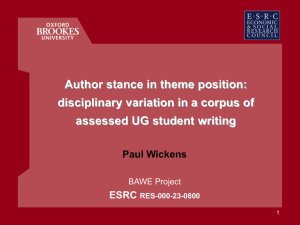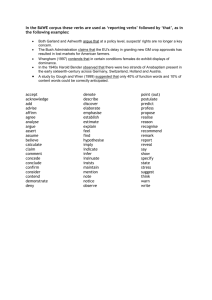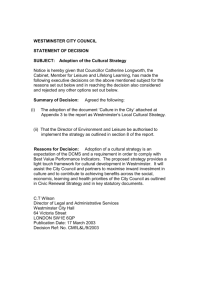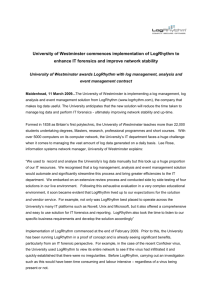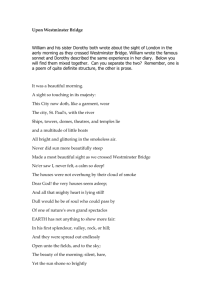Author stance in theme position: variation assessed student writing
advertisement
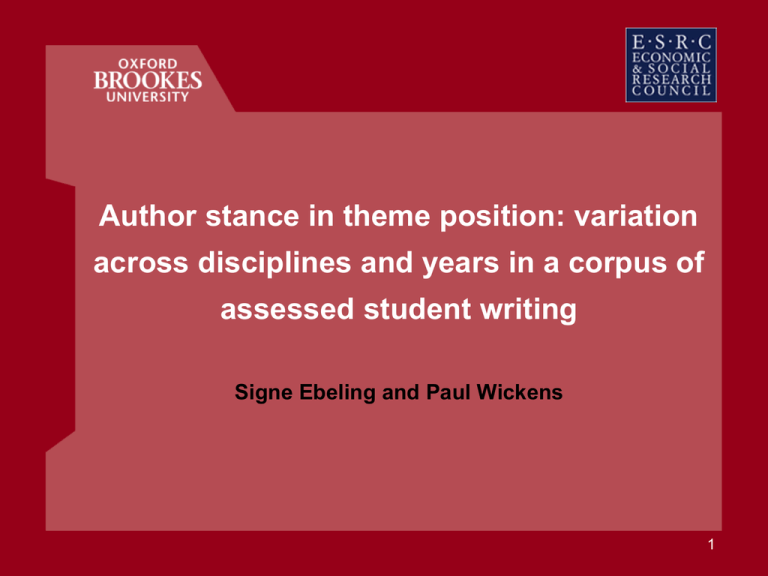
Author stance in theme position: variation across disciplines and years in a corpus of assessed student writing Signe Ebeling and Paul Wickens 1 The British Academic Written English Corpus Part of the ongoing ESRC-funded project An investigation of genres of assessed writing in British Higher Education (RES-000-23-0800 ) Collaboration between Oxford Brookes, Warwick and Reading Universities Collection of 3,000-3,500 student assignments at Undergraduate and Masters level – all marked >60% Four disciplinary groupings: Arts & Humanities Medical & Life Sciences Physical Sciences Social Sciences Westminster Institute of Education BAWE 2 Data selection 1st year 2nd year 3rd year English studies 4 4 4 Engineering 4 4 4 Health and social care 4 4 4 Anthropology 4 4 4 Westminster Institute of Education BAWE 3 Thematic choice, stance and disciplinary variation “The literacy practices of a disciplinary community embody different orientations to knowledge constructions […] The initial constituent of the clause appears to have particular significance in the way it reflects the writer's beliefs and values, and thus provides an indicator of disciplinary difference in professional academic writing.” (North 2005: 435) Aims: point out disciplinary differences and/or similarities in the thematic choices of students’ academic writing. look at possible reasons why disciplines show different or similar tendencies in terms of ‘point of departure of the message’. Westminster Institute of Education BAWE 4 Framework and classification of data T-unit: "an independent clause together with all hypotactically related clauses which are dependent on it" (Fries 1994: 229) Topical theme: typically fills a participant role within the clause and is most commonly found to be the grammatical subject (or the subject of the main proposition) Orienting theme: the elements preceding the topical theme Textual – makes "explicit the way the clause relates to the surrounding discourse" (Halliday 2004: 83) Experiential – may contain fronted hypotactic clauses and “experiential elements which do not fill participant roles (mainly circumstantial adjuncts)" (North 2005: 438) Interpersonal – typically expresses the speaker's "own angle on the matter in hand" (Halliday 2004: 84) Orienting theme Textual …and Experiential in order for practice to be changed accordingly Topical theme Rheme Of course passion, an emotion, cannot be said to physically flow… it is important that the results are trustworthy. Interpersonal Westminster Institute of Education BAWE 5 An overview of orienting themes across disciplines Orienting theme Discipline Year of study Textual Experiential Interpersonal English studies 1190 t-units 22 21 10 Engineering 1405 t-units 19 23 10 Health and social care 1306 t-units 24 20 23 Anthropology 1536 t-units 24 23 18 Figures (approximate) per 100 t-units Westminster Institute of Education BAWE 6 Interpersonal themes in the BAWE material Examples 1) Modal adjunct Clearly force is essential to the complete turn around of rebellious individuals in 1984, (BAWE3003c) 2) Interrogative / inversion Does this leave the individual with any hope? (BAWE3003c) 3) Imperative Consider the use of plastic gears for one stage of speed reduction. (BAWE0023e) 4) Personal projecting clause In both novels, Orwell suggests that every system of power will inevitably abuse the use of language as mechanisms of control, (BAWE3007a) 5) Non-personal projecting clause It is possible that this is more than a criticism of the Bible itself but of the “canonizing process”, which Ostriker also argues has “throughout history rested, not accidentally but essentially, in the silencing of women.” (BAWE3006k) Westminster Institute of Education BAWE 7 Distribution of interpersonal themes per 100 t-units Discipline English Studies Interpersonal theme Engineering Health & social care Anthropology personal projecting clause 3.2 0.3 12.1 8.2 non-personal projecting clause 3.5 5.3 9.7 6.5 modal adjunct 2.9 0.3 0.5 2.9 interrogative/ inversion 0.4 0.5 0.2 0.7 imperative Total 3.4 10 Westminster Institute of Education 0.1 9.8 22.5 BAWE 18.4 8 Interpersonal themes: Projection Muir (2004) states that Non-self Researchers have shown that Personal I propose that I believe Self Projection Non-self Nonpersonal External it is claimed for instance that Internal The graph shows that Self it is clear that There is a possibility that Westminster Institute of Education BAWE 9 Interpersonal themes: projection Personal English Engineering Health Anthropology Non-self 2.7 0 6.7 7.7 Self 0.5 0.3 5.1 0.3 0.3 0.2 0.3 12.1 8.2 English Engineering Health Anthropology Non-Self 2.3 2.6 4.9 3.2 Self 1.2 2.7 4.7 3.2 0.1 0.1 9.7 6.5 Other total 3.2 Figures per 100 t-units Non Personal Other total 3.5 5.3 Westminster Institute of Education BAWE 10 Disciplinary Differences: Personal Projection Non Self English Engineering Health Anthropology 2.7 0 6.7 7.7 Makdisi suggests that John Blades argues that John Blades notes that John Beer states that Blake suggests that 0.5 Self Schon (1987) would say that Mildred Blaxter (1990) notes that Beauchamp and Childress (1989) believe Muir (2004) states that Thompson et al (2004) argue that 0.3 I propose that I believe I think ultimately I would suggest that we can see that you find that I decided that 5.1 0.3 I had always believed that I realise with hindsight that As professionals, we may feel Personally I feel that we cannot confidently say that I am satisfied; however, that Westminster Institute of Education Boyd and Silk suggest that: Semaw (1997) points out that Richard Klein emphasizes that Tim Ingold argues that, Ingold conversely concludes that He claims for instance that BAWE I don’t think I concur that We can fairly safely say that 11 Disciplinary Differences: Non-Personal Projection Non-Self external English Engineering Health Anthropology 2.3 2.6 4.9 3.2 0.6 0.5 3.8 2.5 feminist readings of the turnover data the Bible, and suggests that indeed Atwood’s novel itself, demonstrate that internal 1.6 These actions suggest This symbolises that This passage also suggests that Self 1.3 It seems that it is clear it is natural that Studies have shown that Statistics have shown that It has always been understood that 2.0 The graph shows that The results have shown that 1.1 The results of this may show that These showed that This suggests that 2.7 it appears that it is unlikely that It is expected that it is observed that 4.7 It is also true that it is possible that it is highly unlikely that it was unclear why Westminster Institute of Education BAWE It has been suggested It has been predicted that 0.7 This essay argues that This example shows that This quote shows that 3.2 there is a high probability that it is unlikely It appears that it is not surprising that 12 Mediated or second order learning ‘Disciplinary Literature’ Textbooks Research Literature Lectures Student Writing ‘Object of Study’ Teaching in HE is “… a rhetorical activity, seeking to persuade students to change the way they experience the world (and to) enable students to learn the descriptions of the world devised by others. (…) It is mediated learning, allowing students to acquire knowledge of someone else’s way of experiencing the world. “ Laurillard (1993) p28-29 Westminster Institute of Education BAWE 13 Health Care • Draws equally on literature (P + NP Non-Self) and personal (P + NP Self) as point of deparutre to orientate reader. • Key epistemology is of reflective practitioner: evident in P/ Self. Orienting topical Rheme I was also unaware that post registration, each practitioner is personally responsible for ensuring that practice meets legal requirements and maintaining professional competence, which means keeping up to date with new procedures and policies (NMC 2002). • Clusters of Interpersonal themes. E.g. in conclusion • Projection gives reflective distance and integrates two elements. Westminster Institute of Education BAWE 14 Conclusion 2nd year Health Care Orienting topical Rheme The decision to deceive someone about their treatment is not one that should be taken lightly and I hope that this case study has illustrated some of the areas that should be considered by the team. Although the Mental Capacity Bill (2005) has made the guidelines about non-consensual treatment clearer, it is highly unlikely that the practice of covert medicine administration will ever be detailed by the letter of the law since this could lead to its abuse. Kant would argue that since his categorical imperative cannot be applied, the practice should not be allowed. Most practitioners though, particularly in the mental health field recognise that there are times when an individual may need an intervention even though they don’t want it – Westminster Institute of Education BAWE 15 Anthropology • • • Key focus: Literature as point of departure (P + NP Non-Self) Lack of explicit self (P/Self). Use of NP Self. Example of ‘pattern’ or clusters of interpersonal theme (projection): • Personal Non-Self: arguments in the literature Orienting topical Rheme Concurrently, Katherine Milton (1999) suggests that, ‘using meat to supply essential amino-acids and many required micronutrients frees-space in the gut for (high energy i.e. USO) plant foods (p11). In reply, proponents of the USO’s hypothesis and especially Richard Wrangham, argue that if cooked, tubers could fulfil all the dietary requirements. Westminster Institute of Education BAWE 16 English Studies • Few Interpersonal themes (twice as many Textual and Experiential) • Extensive referencing and quotation exists but little projection: point of departure • Integrated into main clause (use of numerical index system) The way in the Romantic poets ‘revolutionised’ such rational and structured ideas is abundantly evident in William Wordsworth and Samuel Taylor Coleridge’s Lyrical Ballads, “arguably the most important single volume of the romantic period” which “signalled a literary revolution.”[1] [1] Duncan Wu Romanticism: An Anthology Second Edition (Oxford: Blackwell Publishing, 1998) p.189 Westminster Institute of Education BAWE 17 In both novels the dystopic totalitarian regimes purport ways of living in a disturbingly collective manner. In the world of ‘1984’ the distortion of reality by the omnipresent Big Brother creates a society absent of purpose and without the freedom of individual choice. In The Handmaid’s Tale the abundance of biblical imagery, and allusion to various narratives of the Bible generates a harrowing image of a futuristic patriarchal society, which legitimates the humiliation and enslavement of women with literal interpretations of scripture. However, what I would also argue as a key idea in both novels, and also feminist hermeneutics, is the importance of the preservation of the individual self within the larger, collective body. In particular, feminist readings of the Bible, and indeed Atwood’s novel itself, demonstrate that the voices of these individuals should not, and will not, remain silenced. (conclusion • • • • Orienting themes: experiential Circumstances relating to text: object of study Clusters of textual and interpersonal themes for key points Literature or personal stance not often the point of departure In gerneral, writers perspective on the text (object of study) is the main proposition Westminster Institute of Education BAWE 18 Engineering • • • No P/ Non-Self and few NP Non-self. (few references and citation) Little explicit ‘Self’ (P/ Self). There is use of NP/Self NP/ Non-self / Internal – refers to data or proposition established in student’s text. It is unlikely though that anyone could apply his or her full body weight to the drill, as this would unbalance him or her. This principle suggests that the restraints on the beam in the experimental and initial FE model would have no effect on the results due to the distance from the ends exceeding 306mm. However the results indicate that this is not the case where the FE model produced two different sets of results for differing end restraints, with the experimental and theoretical giving two different yield loads. Westminster Institute of Education BAWE 19 References Fries, P. H. 1994. On Theme, Rheme and Discourse Goals. In Coulthard, M. (ed.) Advances in Written Text Analysis. London/ New york: Routledge. Halliday, M.A.K. 2004. An Introduction to Functional Grammar. 3rd edition, revised by C.M.I.M. Matthiessen. London: Arnold. Hyland, K. 2005. Stance and engagement: a model of interaction in academic discourse. Discourse Studies 7 (2). 173-192. Laurillard, D. (1993). Rethinking University Teaching - a Framework for the Effective Use of Educational Technology. London: Routledge. Mauranen, A. 1993. Theme and Prospection in Written Discourse. In Baker, M., G. Francis and E. Tognini-Bonelli (eds.) Text and Technology. In Honour of John Sinclair. Philadelphia / Amsterdam: John Benjamins Publishing Company. 95-114. Nesi, H., S. Gardner, R. Forsyth, D. Hindle, P. Wickens, S. Ebeling, M. Leedham, P. Thompson, and A. Heuboeck. 2005. Towards the compilation of a corpus of assessed student writing: An account of work in progress. In Danielsson, P. and M. Wagenmakers (eds.) Proceedings from The Corpus Linguistics Conference Series, Vol. 1, no. 1. http://www.corpus.bham.ac.uk/PCLC/ North, S. P. 2003. Emergent disciplinarity in an interdisciplinary course: theme use in undergraduate essays in the history of science. PhD Dissertation. The Open University. North, S. 2005. Disciplinary variation in the use of theme in undergraduate essays. Applied Linguistics 26/3. 431-452. Wickens, P. 2001. Computer Based Learning and Changing Legal Pedagogic Orders of Discourse in UK Higher Education: A Comparative Critical Discourse Analysis of the TLTP materials for Law” PhD Dissertation, University of Warwick; Westminster Institute of Education BAWE 20
